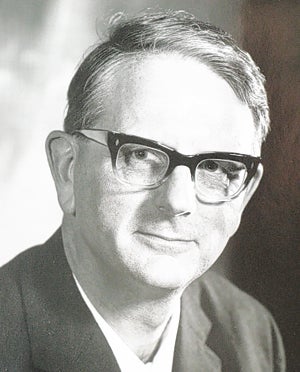Professor Frank Bonsall: Leading mathematician of the post-war years who led research into functional analysis

Frank Bonsall was a distinguished mathematician and a significant figure in the mathematical life of the United Kingdom in the post-war years. His particular interest was functional analysis, a subject that unifies different parts of mathematical analysis within a single more abstract framework, and he was instrumental in raising its profile, particularly in Scotland and the north of England. His research work was characterised by its aesthetic simplicity, and his ability to focus on key ideas and strip out unnecessary complications.
Frank Featherstone Bonsall was born in north London to Wilfred Cook Bonsall and his wife Sarah, from Derbyshire and North Yorkshire respectively. Frank was the younger of their two sons; his brother, Arthur Wilfred, was to serve as director of GCHQ from 1973 to 1978 and was knighted in 1977. In 1923 the family moved to Welwyn Garden City.
Bonsall attended Fretherne House preparatory school, then Bishops Stortford College in 1933. Although he did not particularly enjoy boarding-school life, he excelled academically and in 1938 he went up to Merton College, Oxford, to read mathematics. Later, he recalled how much he enjoyed the freedom of university life, as well as his first encounters with rigorous analysis, the area of mathematics that was to become his speciality.
In 1940 his studies were interrupted by the war, and he was called up to the Royal Engineers, serving for six years. The final two years were spent in India and he took EC Titchmarsh's Theory of Functions with him, thereby keeping his interest in analysis alive. He returned to Oxford in 1946 and graduated with first class honours. During that year he met Gillian (Jill) Patrick, a fellow mathematics undergraduate who became his wife in 1947.
Bonsall then accepted a one-year lectureship at the University ofEdinburgh. The year was a very happy one, during which he met WWRogosinski, a distinguished analyst who had recently been appointed to the chair of mathematics at Newcastle. The next year Bonsall followed him there, taking up a lectureship.
As a self-taught research mathematician, he benefited greatly from Rogosinski's influence and thoughhis early research was along fairly classical lines, he was soon attracted to more abstract analysis. This interest was reinforced by the time he spent with a strong research group atStillwater, Oklahoma in 1950-51. There, he made his first serious study offunctional analysis, which was to be the focus of his research for the rest of his life. After returning to Newcastle, Bonsall became an influential figure in the field and he was appointed to the chair at Newcastle in 1959 when Rogosinski retired.
In 1963, the University of Edinburgh instituted a second chair of mathematics, the McLaurin chair. Bonsall applied and was interviewed by a committee chaired by the principal, Sir Edward Appleton, who immediately wrote to offer him the position. This was one of Appleton's last acts ashe died suddenly that night. Bonsall took up the chair in 1965 but spentthe following academic year at Yale, where he was already committed to a visiting professorship. On his return he did much to strengthen the position of functional analysis. Along with John Ringrose and Barry Johnson at Newcastle, he founded the North British Functional Analysis Seminar, one of the first inter-university seminars in mathematics, and a model for many others.
He made significant contributions to the theory of Banach algebrasand in 1973, in collaboration with John Duncan, one of his former research students, he published Complete Normed Algebras, which was the definitive work of the period. He was elected to the Royal Society of Edinburgh in 1966 and to the Royal Society in 1970.
He was awarded the Senior Berwick Prize of the London Mathematical Society in 1966 and was President of the Edinburgh Mathematical Society in 1976-77. Over the years, he servedon the Council of the London Mathematical Society, committees of the Royal Society and the Science Research Council and on numerous editorial boards.
Outside mathematics, Bonsallhad a great interest in mountain climbing and in his CV he records hisascent in 1977 of his 280th Munro;the Munros are the mountains in Scotland at least 3,000 feet high. Theoriginal list, compiled by Sir Hugh Munro in 1891, has always been the subject of some controversy (when do two close tops count as separate Munros, for example) and the list has seen various revisions.
In two articles in the Scottish Mountaineering Club Journal in 1973 and 1974, Bonsall developed a rule for determining what should be considered asseparate mountains. Application of this rule yields a list very close to Munro's original and influenced some subsequent revisions of SMC's definitive list.
When Bonsall retired in 1984 he and Jill moved to Harrogate, where he was able to enjoy walking the Yorkshire hills and dales and tending his garden, with particular attention to thecultivation of fruit and vegetables. But he maintained his interest in mathematics, and the flow of research papers continued for some years, the last appearing in 2000, just two years before he and Jill moved into a retirement home.
Frank Featherstone Bonsall, mathematician: born London 31 March 1920;Professor of Mathematics, University of Edinburgh 1965–84, then Emeritus; married 1947 Gillian Patrick; died Harrogate 22 February 2011.
Subscribe to Independent Premium to bookmark this article
Want to bookmark your favourite articles and stories to read or reference later? Start your Independent Premium subscription today.

Join our commenting forum
Join thought-provoking conversations, follow other Independent readers and see their replies